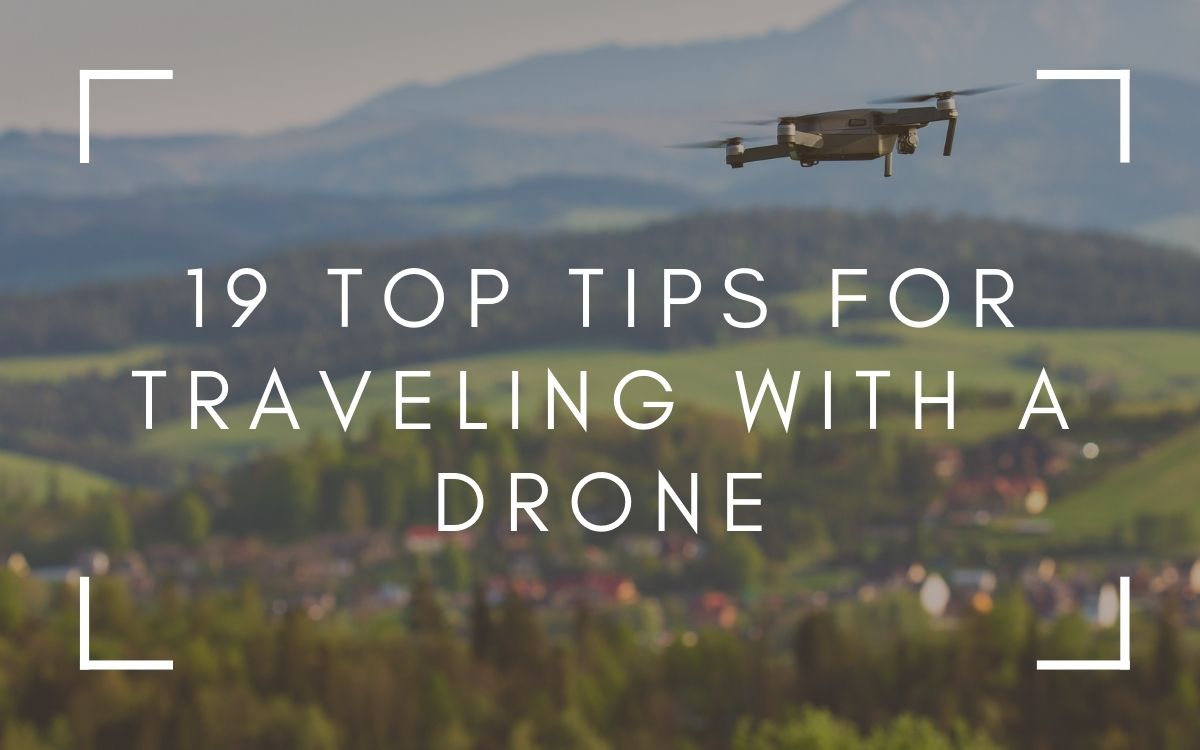When traveling with a drone, there are many things you need to put into consideration if you want to get the most out of your drone and have a great time.
Drones are, without a doubt, one of my favorite inventions in the 21st century. They allow us to view the world from a perspective that was either too expensive or impossible before drones.
If you love traveling, a drone can quickly become one of your most prized possessions as it helps you capture beautiful moments and places you encounter during your travels to different corners of the globe.
In this post we’ll share 19 great travel tips to help you travel with drone and fly confidently, taking some amazing footage for memories that will last a lifetime. I’ve also included a bonus treat at the bottom of the page, my own embarrassing efforts while learning how to fly a drone.
Coming your way in this post - click to expand ->

But before we get going, let’s just have a quick look at a few FAQs about traveling with a drone.
FAQs on traveling with a drone
Can you travel internationally with a drone?
It depends on the applicable laws in the country you are traveling to. Some countries do not allow drones at all while most others, such as the United States, have their own laws regarding drone use which can be very different to the rules in the EU. Check the drone laws for the country you plan to travel to and follow them to the letter. Don’t forget to bring your license with you. If you’re not sure where to check, the civil aviation authority for the country you intend to visit is often the place to start.
Can I travel with my drone on a plane?
Yes, bringing a drone on a plane is almost always OK, but check the rules of the airline regarding the batteries. For instance, American Airlines doesn’t allow passengers to travel with lithium ion batteries that exceed 160 watt-hours. Check the airline’s policy before taking your drone with you and stay below their watt hours limit.
Are drones allowed in hand luggage?
Yes, and bringing your drone onto the plane with you is the best way to travel with a drone. Rechargeable lithium-ion batteries, which is what your drone uses, must be carried in your carry on baggage. You should never check the drone batteries in as they can be a fire hazard. The drone itself, however, can be carried in your carry on baggage or in checked baggage, however, we do not recommend leaving your drone to the fate of the baggage handlers, just keep it with you.
Do I need special insurance to fly my drone?
It depends on the country you are in. In the United States, you don’t need insurance to fly a drone commercially or for recreational purposes. In Canada, you need liability insurance to fly a drone commercially but none for recreational purposes.

19 tips for traveling safely with a drone
- Learn and respect the drone laws each country you visit
- Travel with your drone as carry-on luggage
- Be polite to security
- Try to buy a travel-friendly drone
- Have a solid case
- Pack spare batteries
- Use neutral density filters
- Understand your charging time
- Avoid flying over people and crowds
- Try to have a pre-made flight plan
- Understand how to fly your drone manually
- Maintain line of sight while flying
- Be respectful of animals
- Be cautious in cold weather
- Know the best times to use your camera
- Allow additional time for flying
- Carry basic repair tools
- Have enough storage space and back up memory cards
- Be friendly to the public
1. Learn and respect all the drone laws for every country you will be traveling to
This is very important. As drones become more popular all over the world, different countries are finding it necessary to come up with drone laws to govern what people can and can’t do with drones, and they are all different.
People who don’t respect the rules give all drone fans a bad name and run the risk of encouraging even tighter regulations, so it is important to respect all drone laws.
When traveling with a drone, you have to do your due diligence about the drone laws applicable in the places you’ll be visiting so that you abide by them. You should also check them regularly as they keep on changing. In the EU, they are regularly updating the civil drone laws, so what you knew last year, may no longer be true.
Always also check if you are required to register your drone with the nation’s civil aviation authority. In many places, it is one of the first things you’ll have to do and often isn’t a fast process. I sadly didn’t do this on a recent trip to Portugal and it takes up to two weeks to get the paperwork sorted, so I couldn’t fly my drone on that trip
2. Travel with your drone as carry-on luggage
Air travel is possible with a drone, but it an expensive and fragile piece of equipment, and you don’t want it being handled by airport checked baggage staff. Also, drone batteries are made of lithium, and they can be a fire hazard.
In fact, it wasn’t that long ago I was flying from London to Chicago and thought I could smell burning. Looking around at some other passengers, I could see the fear on their faces as they could also smell it. When we spoke to the airline staff, they explained there had been a small lithium battery fire but the plane’s control system had alerted them, it was already out and nothing to worry about.
But. Trust me when I say, smelling burning when you are 38,000 feet above the Atlantic Ocean does absolutely nothing good for your nerves. I hate flying at the best of times, that nearly killed me.
So . . . if you are taking your drone on a plane, you should avoid placing your drone in your checked baggage instead, carry the drone and accessories with you in your carry on baggage. You will have to check the airport policy first though as some may require you to transport your drone in check-in luggage.
3. Be nice to airport security
With airport security, cooperation and politeness can really go a long way. Drones are not common, and there’s a high chance that airport security will have a lot of questions for you before allowing you to pass through their checkpoints.
Being polite and responsive to their queries and helpful in getting your drone in and out of your carry on bag and it will make your air travel experience way more efficient.
4. Buy a travel friendly drone
Drones come in different shapes and sizes. For instance, the Phantom 4 and Mavic Pro are both popular drones that are both made by DJI.
However, the bigger size of the Phantom 4 makes it difficult for traveling with it in your carry on baggage across multiple countries, even though it is an excellent drone. The DJI Mavic Pro, on the other hand, is an excellent drone for traveling due to its compact size.
5. Have a good case
A drone case is essential when traveling with a drone as it protects your drone and makes it comfortable to carry around. With a case to protect it, you can throw your drone into any bag without worrying about anything happening to it.

6. Have extra drone batteries
The best drones in the market right now average about 20-30 minutes of flight time on a full battery. Often this is not enough to record everything you need to. Therefore, always carry extra lithium ion batteries are vital to avoid losing flight time.
With spare batteries, you can easily switch batteries then continue recording your videos or taking pictures as the other batteries charge up. I recommend a minimum of two spare batteries.
Be sure you know the watt hours of your spare batteries if you are flying as most airlines have a limit on the maximum amount you can travel with. If it Is under 100 wh, you should be OK, but you if they are more powerful, be sure to check your airline rules. According to the FAA, drone batteries over the 100 wh are limited to one in the drone and two spares, so a total of three.
Also, bwtteries must be for personal use only. If you decide to rock up at the airport with 50 batteries all under 100 watt hours, although it’s kind of OK, expect a lot of questions to justify that they are all for personal use.
You might also need to pack a car inverter to help you charge your drone batteries in vehicles and one final warning – DO NOT put them in your checked baggage.
7. Use neutral density filters
Neutral Density filters are a must-have item for your travels. Most drones come with fixed aperture leaving the automatic settings to decide on what shutter speed and ISO is to be used to get a balanced exposure. Often it is wrong. Sometimes if you forget to lock the settings, it may change mid-shot leading to crappy footage.
If you make sure you use a neutral density filters, it will limit the chances of this happening.
8. Know your charging time
How long does it take for your drone battery to charge fully? Be sure you learn what this is as it can be quite a long time. I usually have to charge my drone for 3-4 hours to get 25 minutes usage!
9. Avoid crowds
First of all, flying a drone with a camera near crowds is often prohibited under most countries’ drone laws to protect people’s privacy. Not everyone wants to be turned into an Instagram hashtag!
Also, using your drone near a group puts them at risk if anything goes wrong. Drones can run into technical difficulties any time, and even though a drone is small, it can cause terrible injuries if it crashes into a person.

10. Always have a flight plan
Before sending your drone up in the air, particularly in a new place, it is important to first come up with a flight plan. This allows you to plan for how you will record the footage you need in time and also ensures that the drone stays in range during the entire flight. Take note of trees, power lines, buildings, and other large objects that you need to stay away from.
11. Learn how to fly your drone manually
Sometimes you may not have direct video streaming when flying your drone or even worse, you could lose it mid-flight. If you know how to operate your drone manually, you can quickly get it back to your location for a safe landing.
12. Maintain line of sight while flying
You should always keep your drone within your visual line of sight so that even if your direct video streaming is inactive or malfunctioning, you may still be able to see the drone and bring it back to you safely.
13. Be respectful to animals
Some animals, particularly birds and dogs, don’t really like drones as the sound they make may be scary to them. Some bird species, such as seagulls, may actually attempt to attack the drone thinking it’s another animal.
You should always try to be aware of any animals in the area you are flying in and keep a safe distance from them. This also applies for game drives, and most wildlife parks will already have strict guidelines regarding drones.
14. Be cautious in cold weather
We all know that there has never been a friendship between electronics and cold/wet weather. Consumer drones are not really designed to operate below freezing temperatures or in rainy conditions. If you are visiting a cold region, be careful as sometimes drones can fall out of the sky in extreme conditions.
15. Fly at the best times to shoot
According to most drone owners, the best time to use your 4k camera drone to take photos or videos is early in the morning, during or just after sunrise, and in the evening, during or just before sunset. This is because the lighting is fantastic during these times and there will likely be fewer people around.

16. Allow additional time for flying
You should not be so occupied with setting up the drone and capturing footage that you miss the experience of the location you’re touring. Setting up your drone and capturing footage will take some time, so make sure you allocate enough for that and still leave some for you to enjoy your moment too.
17. Carry basic repair tools
You never know what will happen during the trip. Your drone could crash or get damaged while in the middle of nowhere. If you have repair tools with you always, it is possible to fix your drone wherever you are.
You’ll also need to carry extra spare parts, especially the propellers, since they are usually the first part to get damaged after a crash.
18. Have enough storage space and back up memory cards
One of the things you want to avoid is being unable to record due to insufficient storage space. You don’t want to be forced to delete some items to create room for more. Bringing a few extra memory cards is a good idea to be on the safe side.
19. Be friendly to the public
There’s a high chance that many people you will encounter during your travels have never seen a drone in action. As such, you will likely attract some attention from the locals who also want see what you’re up to.
Take this as an opportunity to chat with them, put their mind at ease so they realize drone pilots are nice people and even offer to take their photos or videos with your drone. You could make lots of new friends by being polite.
*Bonus tip: Have Fun!
Your trip is not just about flying drones and recording footage. Take the time to enjoy your trip and all it has to offer. Don’t forget to take amazing dronies to show off to your friends on social media!
My personal drone skills
I can’t finish without sharing my little montage. This was back with my first drone that didn’t even have altitude hold. The difference with modern drones is amazing, but learning to fly with one of these was certainly a challenge.


Thanks for all you said
Thanks, glad you found it helpful.
It was funny to see your first drone, the same happend to me, also I couldn’t take any picture with it, now 1 month ago I bought a Mavic air 2 and its very easy to fly it. I liked your post it’s gonna help me a lot, I’m from México and I will travel constantly to Houston with my drone.
Haha, I think a lot of first drones become victims to trees! Nice choice on the Mavic air 2, great bit of kit. I currently use a Fimi X8, which is like a copy of the DJI Mavic from Xiaomi. It’s a really good choice if the DJI is a little out of reach price-wise. Just be sure to keep an eye on the US drone laws as they change regularly. Happy flying!